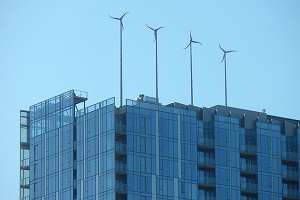Simulations pinpoint wind turbine vantage points

Putting small and medium-size wind turbines in the wrong place within built environments can cause them to be less effective—or even have no effect at all—according to research from a Murdoch University PhD student.
Amir Tabrizi, from Murdoch's School of Engineering and Information Technology, used computational fluid dynamics (CFD) in a study that explored the safety and performance of wind turbines while gaining an insight into their inflow conditions.
"Installation of small and medium-size wind turbines on the rooftops of high buildings has often been suggested by architects and project developers as a valuable solution for achieving sustainable energy in building design," he says.
"But the performance of small wind turbines in the built-environment is really sensitive to the place you put them. If you put them in wrong place, you will not get any power.
"Unfortunately, there are several bad examples around Perth where they have put the machines in shadow and they don't work, not even in windy conditions."
Mr Tabrizi found existing standards used by small wind turbine manufacturers do not have any specific classes for built-environment application, only addressing their use in open-terrain.
"Because wind has more turbulence in the built-environment, some of the machines installed in these areas failed and broke," he says.
"There was some damage to cars in parking lots, due to broken blades from the small turbines.
"A specific class is needed in the standards to address designing these machines for built-environment application via attention to a higher level of turbulence intensity."
The use of CFD in the research provided a cheap tool to gain a more accurate assessment of wind resources in the built-environment.
"Through wind simulation in the target area, CFD helps to find the right place for the turbine with higher wind speed to avoid re-circulation and shadow zones, also putting the machine where it will generate more power," Mr Tabrizi says.
"CFD simulation also helps you to get the right idea about turbulence levels on your target site, such as high and low turbulence zones so the machine can be put in a place with lower turbulence intensity to minimise the risk of it failing.
"For sites with turbines already in place, CFD simulation can show whether there are better opportunities for them on the site."
Mr Tabrizi highlighted five small turbines installed on the edge of the roof at Bunnings Port Kennedy warehouse—CFD has shown there is higher wind velocity and less turbulence on the middle of the roof, indicating that would be better a place for them.
More information: Amir Bashirzadeh Tabrizi, Jonathan Whale, Thomas Lyons, Tania Urmee, Performance and safety of rooftop wind turbines: Use of CFD to gain insight into inflow conditions, Renewable Energy, Available online 8 December 2013, ISSN 0960-1481, dx.doi.org/10.1016/j.renene.2013.11.033.
Journal information: Renewable Energy
Provided by Science Network WA




















